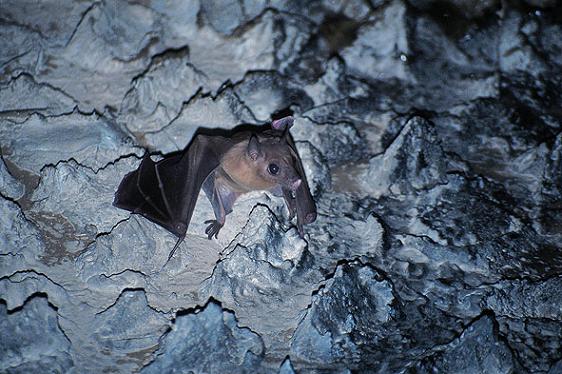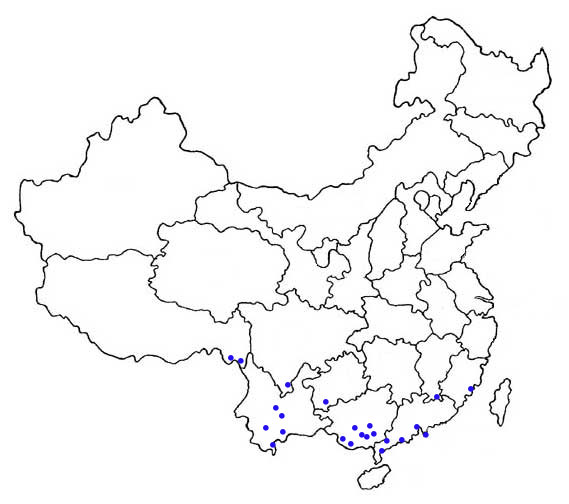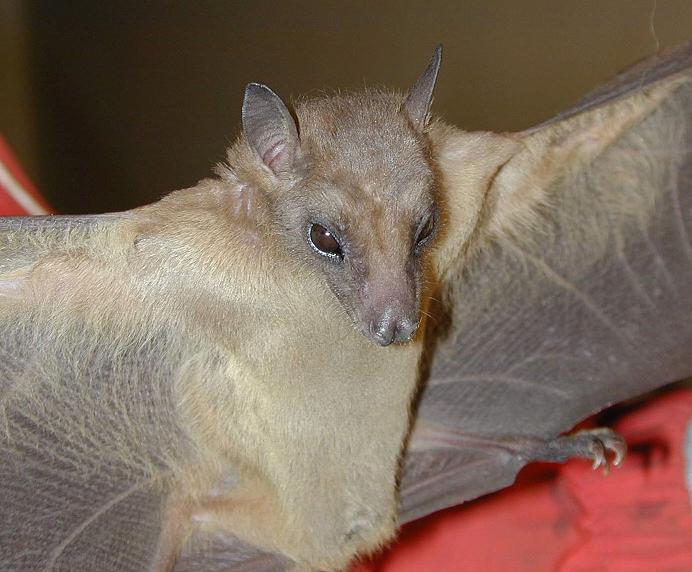Rousettus leschenaultii
Leschenault's Rousette, Fulvous Fruit Bat
Morphological description Life history Distribution Habitat Roost sites and roosting patterns Emergence and flight pattern Foraging behaviour Echolocation calls Status and protection

Morphological Description
· Dorsal fur is fulvous brown, including crown of the head, back, flanks, and throat. Ventral fur is grey or brown-grey, more greyish in the median area.
· Average forearm length 80.6mm (75-86mm) (Bates & Harrison, 1997).
Life history
· In some areas of India this species can undergo two pregnancies in a year. Young are born at 12g, and suckling may last 35-40 days. Females may attain sexual maturity at 5 months, males at 15 months (Bates & Harrison 1997).
Distribution
Wide ranging: found from Pakistan, India and Sri Lanka to Myanmar, southern China, Java and Bali (Bates & Harrison 1997).
The Chinese distribution is shown by dots on the map below (as given by Zhang et al. 1997).

Habitat
· It ranges from arid areas to the hot humid forests, extending from sea level to 1372 metres (Bates & Harrison, 1997).
· This species has a wide habitat tolerance.
Roost sites and roosting behaviour
· Generally, they roost in caves during the day, also in deserted buildings and disused tunnels.
· Occasionally, solitary males may be found in the dense foliage of a large-leafed tree or palm (Bates & Harrison, 1997).
· This species can share their roosts with other bat species (e.g. Heshang Cave , Fumin County, Yunnan, China).
Emergence and flight pattern
· Emerges about 45 minutes after sunset in Madhya Pradesh, India (in Bates & Harrison1979).
Foraging behaviour
· Forages in forests with fruits, fruit farms.
· The diet mainly consists of fruits (12 species in 9 families), and leaves of one plant species in Xishuangbanna, Yunnan Province. Dietary overlap with Cynopterus sphinx was relatively high in the rainy season (June - October), while the species left the area in the dry season (November-December) when food was scarcer (Tang et al . 2005).
· It is also reported that they can occasionally feed on fish in India (in Bates & Harrison 1997).Echolocation calls
This species emits clicks by moving its tongue against the roof of its mouth. Echolocation clicks range from 60-12 kHz with most energy at around 18 kHz.
Status and protection
· There is no estimation of population size China.
· This species is regarded as pest mammal in the area of fruit farms in Guangxi and Guangdong province, because they eat fruit.
· Large numbers of skulls were found in a cave in Guilin, Guangxi.
· Fulvous fruit bats are at LR/lc, assessed by the Red List of Threatened Species (IUCN, 2006). They are widely distributed and common in some areas of southern Asia. They are not listed in the Law of the People's Republic of China on the Protection of Wildlife in 1989.
· It causes little damage to orchards. Probably important for seed dispersal. May be persecuted by fruit farmers.
· Possible threats may be habitat loss through development, dams, and deforestation, is also hunted for medicinal purposes (IUCN, 2006).